Create
Vintage St. Pete: MGM’s Bounty
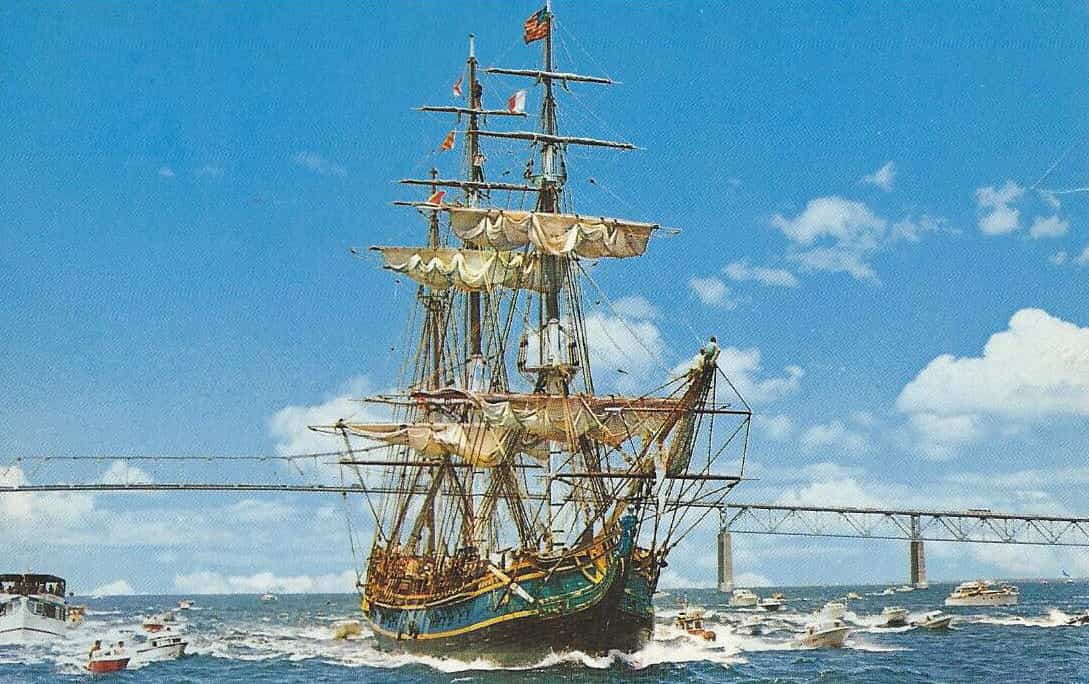
 Thirty-five summers have come and gone since Regan Garnett last stood on the windswept deck of the HMS Bounty, the replica 18th century wooden ship docked for the amusement of tourists at the St. Petersburg Municipal Pier.
Thirty-five summers have come and gone since Regan Garnett last stood on the windswept deck of the HMS Bounty, the replica 18th century wooden ship docked for the amusement of tourists at the St. Petersburg Municipal Pier.
Her father was ship’s carpenter – he repaired, repainted and replaced every wooden inch of the 180-foot, three-masted sailing vessel, which in those days rarely sailed anywhere more exotic than Tampa, for the Gasparilla Festival “pirate invasion.”
Regan Garnett was 12 years old when she and brother spent that final summer at the Bounty exhibit. “It’s funny,” she says, “even going into Home Depot now, I smell the Bounty. That wood smell. And it was so hot! They had these big fans in there. All I wanted to do was walk down to the beach and get in the water.”

Captain/general manager Hugh Boyd and his son Tom. Boyd family photo.
The memories are even more visceral for Tom Boyd, whose own father was captain of the ship and general manager of the exhibit. The Bounty was Tom’s second home.
From memory, he can recite the narration that greeted visitors once they’d purchased their tickets, a recording of his dad’s voice giving a simple, easy-to-understand history lesson:
Well, ha-ha, hello there mates. Welcome to the Bounty. Say, have you noticed a special kind of flavor in the air since you came? Why it’s oakum, tar, black spruce, oak, pine and manila … yes, and even old sweat. That’s one way of knowin’ that you’ve not come aboard a phony, but a real wind-battlin’ timber-shakin’ swell-bustin’ windjammer. Ah, you could drop a sea-bag in any port in the world, and not see the likes of the ship you’re aboard right now. Say, if you’ve got a minute to spare and are partial to a little yarnin,’ I’ll tell you why that is. My name’s Hugh Boyd, I’m bosun on the Bounty and I’ve been with this barnacle-bottomed old wind harpy ever since she came down the ways in Lunenberg, Nova Scotia in 1960 and kissed into the Atlantic.
When Tom Boyd was 10, in 1979, his father put him to work. “They had me cleaning the toilets so that nobody thought I was a captain’s son,” Boyd laughs. “He said ‘Well, you can always say you worked your way up from the bottom.’”
The ending first
In 2012, the ship known as Bounty sank off the Coast of North Carolina during Hurricane Sandy. The then 62-year-old vessel was in the possession of the HMS Bounty Organization LLC, out of Fall River, Massachusetts, which sent her around the world on educational missions, film shoots and promotional tours.
The tragedy, in which Captain Robin Walbridge and crew member Claudene Christian died, marked the final leg of a remarkable journey.
Bounty was conceived in England, midwifed in Hollywood and birthed in Nova Scotia – but the square-rigger’s formative years were spent in St. Pete, where up to 250,000 visitors annually took above- and below-decks tours.
Metro-Goldwyn-Mayer commissioned the construction of Bounty in 1960, for use in the filming of Mutiny on the Bounty, the second American cinematic treatment of an actual 1789 rebellion aboard a British military vessel in the South Seas.
In MGM’s $19 million adventure, Marlon Brando played chief mutineer Fletcher Christian, driven to near-madness by the sadistic captain William Bligh (Trevor Howard).
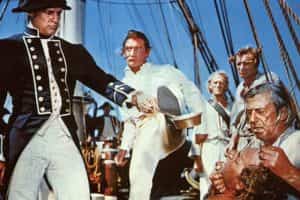 Never mind that this film adhered to the historical facts even less than the legendary 1938 version, with Clark Gable as Christian, and Charles Laughton as Bligh. Hollywood never let the truth get in the way of a good story.
Never mind that this film adhered to the historical facts even less than the legendary 1938 version, with Clark Gable as Christian, and Charles Laughton as Bligh. Hollywood never let the truth get in the way of a good story.
In 1938, California’s Catalina Island stood in for Tahiti and Pitcairn, where the actual events took place. For its Ultra Panavision 70mm Technicolor spectacular, MGM sent actors and crew halfway around the world, to the original locations.
Using the original Bounty plans located in the British Admiralty Archives, a replica – slightly larger, to accommodate cameras, crew and equipment, and with twin diesel engines tucked away – was built in a shipyard in Lunenberg, Nova Scotia at a cost of $1 million. The faux Bounty set sail for the South Seas in August, 1960.
Aboard as an able-bodied seaman was Hugh Boyd, from nearby Dartmouth. Like most of the young crew, he’d signed on because the adventure – a voyage to Tahiti to make a movie with Marlon Brando? – sounded like heaven.
Upon arrival in Tahiti, as a rite of passage Boyd received his first earring. A fellow sailor punched a nail through his earlobe, and sterilized the wound with urine.
As Mutiny on the Bounty opened around the country in 1962, MGM sent its million dollar baby to coastal cities, as promotion. (The film, however, turned out to be a costly flop, and nearly bankrupted the studio).
While Bounty was berthed at the 1964 World’s Fair in New York, MGM’s marketing chief closed a deal with the St. Petersburg City Council to give the ship a permanent home in the Vinoy Basin, where it would remain tied up near the entrance to the pier as a tourist attraction.
Creating the bayfront
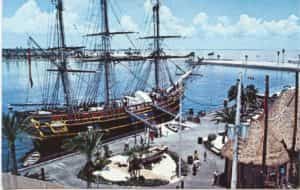 The St. Pete waterfront had a banner ’65 – both the Bayfront Center and the Museum of Fine Arts debuted in the spring, and Bounty arrived in June. A “Tahitian village” was created to house the gift shop and administrative offices.
The St. Pete waterfront had a banner ’65 – both the Bayfront Center and the Museum of Fine Arts debuted in the spring, and Bounty arrived in June. A “Tahitian village” was created to house the gift shop and administrative offices.
The attraction – officially called MGM’s Bounty Exhibit – opened on Friday, July 2. St. Petersburg mayor Herman Goldner gave a speech, and the ribbon was cut by former Miss America Mary Ann Mobley, flown in by the studio for the occasion.
Admission was 90 cents for adults, 50 cents for children.
Hugh Boyd was soon promoted to captain. His assistant exhibit manager, Jeff Frank, had also been on that voyage from New York to Florida, as an engineer.
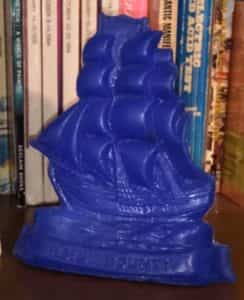 Frank also managed the all-important gift shop, which turned out to be the real moneymaker. “If we had just depended on the admission alone,” he says, “I don’t think it would have stayed as long as it did.”
Frank also managed the all-important gift shop, which turned out to be the real moneymaker. “If we had just depended on the admission alone,” he says, “I don’t think it would have stayed as long as it did.”
 Along with representatives from the Aquatarium, Sunken Gardens, London Wax Museum and Tiki Gardens, Frank created the Pinellas County Attractions Association, so that they could all be marketed under a single banner.
Along with representatives from the Aquatarium, Sunken Gardens, London Wax Museum and Tiki Gardens, Frank created the Pinellas County Attractions Association, so that they could all be marketed under a single banner.
Frank reported 85,000 visitors during Bounty’s first six months.
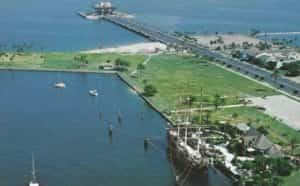 The ante was upped when Walt Disney World opened in 1971. “Disney overall brought people to Florida,” Frank believes. “Do they want to spend a whole week’s vacation in Orlando, or do they want to come to the Florida beaches? That’s something we always struggled with, tying to bring people to the Pinellas County beaches and hence the attractions as well.
The ante was upped when Walt Disney World opened in 1971. “Disney overall brought people to Florida,” Frank believes. “Do they want to spend a whole week’s vacation in Orlando, or do they want to come to the Florida beaches? That’s something we always struggled with, tying to bring people to the Pinellas County beaches and hence the attractions as well.
“We were never that sophisticated in our marketing to see how Disney drew our customers away from us.”
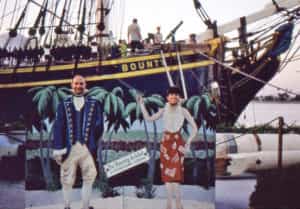
Anonymous visitors, date unknown.
Through she rarely left the dock, Bounty was maintained as a fully operational tall ship. “Gasparilla was a yearly trip, and everybody got so excited because we were actually moving her,” Tom Boyd reflects. “We didn’t put much sail up in those days, but we had good engines, and Dad was always an expert at picking out good engineers.”
Sometimes the crew would get hired out to raise the sails and visit Pensacola, or Fort Lauderdale, as a sort of mobile historical artifact.
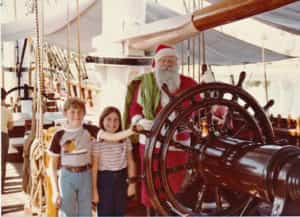
Painter Don Fournier as the Bounty Santa. With Regan Garnett and her brother Paul. Garnett family photo
Hugh Boyd did a little bit of everything, although he wasn’t much for public speaking and conducting tours. He hired more gregarious people to talk to the customers.
“It was a surprising assemblage of skills,” his son says. “He’s immensely patient, and extraordinary generous, and really committed to the ship.
“I don’t know that he ever realized, but he took his role as steward of this ship in such high regard. And he was always one for restoring it, and bringing it back to its original grandeur.”
Recalls carpenter Paul Garnett: “Hughey knew everything about that ship inside out and backwards and forwards. I learned a lot about the way she was constructed in Canada. He was always our link to the past.”
Garnett was invited to join the team in 1979, after he’d hand-delivered a stunning 14-foot replica Bounty he’d created in his Boston workshop.
As planking, mast sections or trim cracked or rotted out, Garnett would replace them using – when it was available – the original lumber, and working from the original British blueprints.
Like Hugh Boyd, Jeff Frank, rigger Royd Wheedon and the others constituting the fulltime crew, Garnett took tremendous pride in his ship.
“After she went down in the hurricane,” Garnett says, “people were saying ‘Oh, well, it wasn’t a real ship – it was a movie prop.’ I saw red when I heard that. Because she was never, ever intended as a movie prop. The studio had built a ship made to go all the way to Tahiti under her own sail power. And then go around the world on a publicity tour.
“Now, you can’t do that on a ship that’s just a floating platform. How the hell do you send something like that across an ocean?”
She was, indeed, a real wind-battlin’ timber-shakin’ swell-bustin’ windjammer.
Pirate ships
Garnett wasn’t able to go on Bounty’s biggest adventure, in 1982. Hired out to “play” a pirate vessel in the British/American comedy Yellowbeard, the ship motored across the Gulf of Mexico and through the Panama Canal to the shooting locations in Mexico.
His daughter, 9-year-old Regan, had been ill. She wrote him a letter – which he still has – imploring him not to take the trip, and, she admits today, guilt-tripping him.
Tom Boyd went along, however. At 13, he helped out in the kitchen and stood night watch.
Assistant manager Jeff Frank was on the voyage, too, but flew home to St. Petersburg before actual work on the movie began. Although the ship was gone, the Tahitian village and the gift shop remained open, and he had to get back to work.
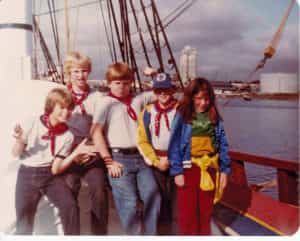
Headed into Tampa for Gasparilla, from left: Jeff Frank Jr., unknown, Tom Boyd, Paul Garnett Jr. and Regan Garnett. Garnett family photo
Upon Bounty’s return, six months later, things quickly got back to normal.
The Bounty kids resumed their regular weekend routines of hanging around, getting sodas and chips from the vending machines and eating “lunch” with their feet up in the 18-foot longboat display.
An outdoor cage was added to the village, with a quartet of tiny squirrel monkeys inside. “And I had to clean up after the little buggers,” Tom Boyd says. “Occasionally, they would get loose – and they were just dying to get over to that ship. They hauled ass and would not be caught.”
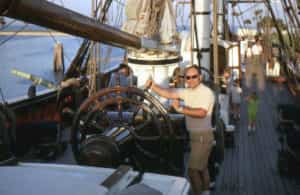
Anonymous visitor, date unknown.
Regan Garnett: “My dad would be like, ‘You guys go sit and do something.’ He’d be in the back, carving and painting, and doing other stuff back there. And we’d terrorize the squirrel monkeys. I’d pitch rocks in the longboat. My shoe got stuck in one of the drain holes on the ship and went halfway down.”
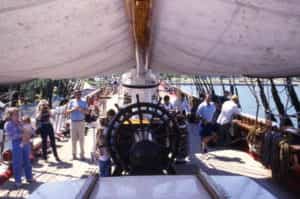 Garnett, who later pursued a career in theater, is convinced the Bounty was essential training. “I think my being comfortable talking in front of people started in that exhibit,” she says. “I had nothing else to do.
Garnett, who later pursued a career in theater, is convinced the Bounty was essential training. “I think my being comfortable talking in front of people started in that exhibit,” she says. “I had nothing else to do.
“Kids would run around. The parents would try to get the real tour, with Mr. Boyd or whoever was giving the tour, so I’d take the kids and walk around. I’d try to do the same tour. It was like one of my first acting jobs.”
In 1985, cable TV magnate Ted Turner purchased MGM, including its legendary film library. He was surprised, the story goes, to find he was also the owner of a fully-operational sailing ship.
The exhibit at the St. Pete Pier was dismantled, and Bounty – still captained by Hugh Boyd – was completely refurbished, including a full set of sails, using Turner money. On Independence Day weekend 1986, it participated in the massive Parade of Tall Ships in New York harbor.
After a trip up and down the Eastern Seaboard, where Turner used the ship to entertain affiliates, he sent it south, where it was moored for three years at a Miami development called Bayside Marketplace.
Hugh Boyd stuck it out for a while, but resigned after the Bayside venture. Frank, Garnett and Wheedon had already bailed by that point.
Turner ultimately donated the vessel to the Fall River Chamber Foundation, which continued to bring Bounty to the Vinoy Basin for the winter months for much of the 1990s. There, without the Tahitian village, the squirrel monkeys or any mention of Marlon Brando, it would be available – a working historical artifact – for visitors to tour.
HMS Bounty Organization LLC bought the ship in 2001, and continued to lease her for film and TV work. Bounty appeared in the second Pirates of the Caribbean movie, and in the 2005 big-budget pornographic film Pirates (the filmmakers reportedly lied to the ship’s owners about the sort of movie they were making).
Then came Oct. 29, 2012. The last photos of Bounty show her foundering and sinking, 90 miles southeast of Hatteras, N.C.
For Paul Garnett, it was like losing a member of the family. “They had done so much to her,” he says. “To my way of thinking, she wasn’t even the Bounty any more. They had changed so much.
“All you have to do is look at pictures or her from the early years, and look at her later – right up to the time they took her out and lost her.”
Tom Boyd has a unique way of thinking about Bounty’s demise. “One of the more rebellious sailors on the ship decided to paint the bell orange with black polka dots,’ he remembers. “And I think about that bell resting on the bottom of the Atlantic Ocean, with a big ol’ octopus using it as a carapace.
“That’s where I’ve put her in my mind.”
This story appears in the book Vintage St. Pete: The Golden Age of Tourism – and More.
Rest in peace Hugh Boyd and Paul Garnett.
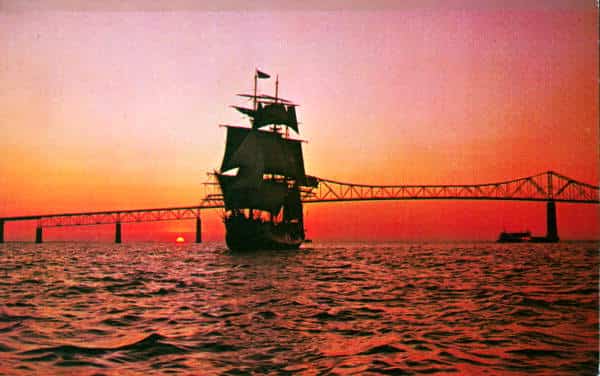




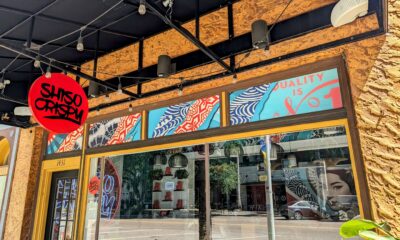

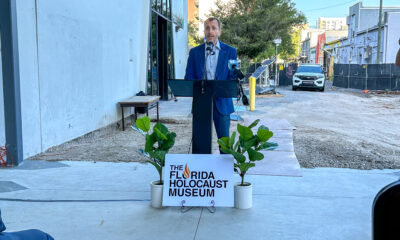

William James
April 17, 2023at2:41 am
Watching the movie again, and decided to explore the ship’s history. Having been born in St. Pete (Mound Park), drove cab there, payroll clerk during building of Bayshore Towers, I’ve always regretted not touring the Bounty. So sorry to learn of her demise, and the loss of life.
Walter Circle
April 11, 2022at8:27 am
I was born & raised in St.Pete.,Fl(aka: DaBurg by locals). When The Bounty was docked at the end of the inverted Pier in the 1960’s my Mother used to take me to tour The Bounty very often. I just wanted to walk around The Bounty & the village as often as Mom was willing to take me there. We went so often that Mom decided it would be cheaper at one point to purchase a pass good for one year of tours & I still have that Bounty pass. I’ll never forget walking around on the Bounty & was so sad to hear that she had sunk during hurricane Sandy. When I was in my 30’s I drove the trolley at the St.Pete. Pier for a couple years. I’ve bought a home & lived in Hudson,Fl for the past 12 years. 😎
Linda Schneegold
January 27, 2022at8:49 pm
Back in the mid 70s I was a sunken Gardens model and a model for the city of Saint Petersburg and I did several shots on the bounty ship. and I’m still alive and well and kicking and wished I could’ve been there in your archives, for this boat brings back a lot of memories. I climbed the mast and sat on the plank and it was wonderful